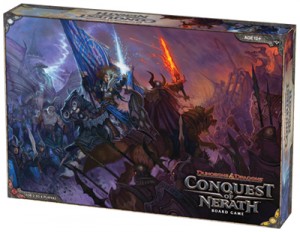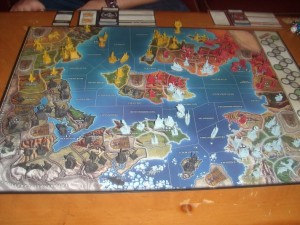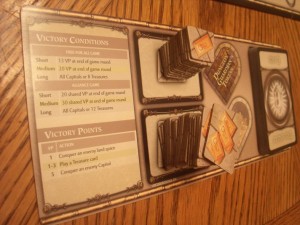A Call to War
 Conquest of Nerath is the latest board game from Wizards of the Coast – but it’s not your typical D&D dungeon crawling fare as it compares to games like RISK or Axis & Allies. I wasn’t interested in the game at all when I’d first heard about it, yet after mounting curiosity and an ever-widening strategic wargame hole in my soul, that changed. I’m very pleased with the outcome because it’s fun game with simple rules yet provides a good strategy experience and in a short amount of time too.
Conquest of Nerath is the latest board game from Wizards of the Coast – but it’s not your typical D&D dungeon crawling fare as it compares to games like RISK or Axis & Allies. I wasn’t interested in the game at all when I’d first heard about it, yet after mounting curiosity and an ever-widening strategic wargame hole in my soul, that changed. I’m very pleased with the outcome because it’s fun game with simple rules yet provides a good strategy experience and in a short amount of time too.
Another noteworthy element about the game, at least for us speculative D&D folk is that the map included in the game expands on the “core” 4e setting far, far beyond just the Nentir Vale. Detailing some very interesting areas as well as classic dungeon locations I wonder if these map locales are a sign of things to come for 4e D&D? I sure hope so.
With 4 armies total the game is for 2-4 players in either an allied mode or every player for themselves. The armies are: Karkoth (Undead), The Iron Circle (Orcs, Goblins, Golems), Vailin Alliance (Elves) and the League of Nerath (Humans, Dwarves) in allied games Vailin and Nerath are paired together, as are Karkoth and Iron Circle. The armies have set turn orders, which may seem awkward at first but it helps blance the game and will quickly make sense after playing.
Each of the playable armies also has its own event cards, which are really what help set them apart from one another. Vailin is best at sea, Karkoth is best on land, Iron Circle is an even mix of both and the League of Nerath is the underdog but has extremely powerful event cards that can truly turn the tide of the game at any moment.
Setup & Tear Down
 Getting everything ready to play is a tedious task, at least the first time around. Each army needs to be placed on the board each in their assigned territories which takes a while when you’re new to the game and due to the sheer number of pieces. Reference cards need placeing, event & item decks shuffled and currency and dungeon tokens readied for use – after all that you’re finally ready to play.
Getting everything ready to play is a tedious task, at least the first time around. Each army needs to be placed on the board each in their assigned territories which takes a while when you’re new to the game and due to the sheer number of pieces. Reference cards need placeing, event & item decks shuffled and currency and dungeon tokens readied for use – after all that you’re finally ready to play.
When placing army pieces don’t do as I did and hunt for the territory land names, location & army pieces laid out on the back of the quick reference card because their color coded indicator icons are also printed directly on each land space on the board. Duh.
Thankfully tear down for the game is quick and easy, the box is truly aimed towards the anal retentive gamer who likes all of their pieces organized to a T, which leaves much to be said for the other D&D board games…I’m looking at you Castle Ravenloft.
Gameplay
The gameplay is a lot less complex than you might think if you’ve only gotten a quick glance at the rulebook so don’t let it intimidate you. Units have varying movement rates and rules including simple land/sea combat and unit transport rules that are just complex enough to make sense without having to reference the rule book every game. You’ll end up not needing anything but your reference card by your 3rd play session.
 Each turn you’ll move your units, fight battles and collect income in which you’ll use to buy more units for your army or place castles on conquered territories which allow you to spawn units from that point. Beware though if your castle is overthrown by the enemy they’ll receive a huge victory point bonus!
Each turn you’ll move your units, fight battles and collect income in which you’ll use to buy more units for your army or place castles on conquered territories which allow you to spawn units from that point. Beware though if your castle is overthrown by the enemy they’ll receive a huge victory point bonus!
When it comes to combat it’s dead simple: roll a 6 to hit. Yes, every unit – but they don’t all use the same die. Foot soldiers roll a d6 to attack so yes, hitting with them is rather difficult, however the other creatures ranging from fighters, wizards and seige weapons to monsters, elementals and dragons all attack using a gamut of dice from d8 to d20’s. Each one has its own small perk or special abilities but lets not delve into minutia.
Other elements really set the play experience apart from those touting it as ‘D&D themed RISK’ are the dungeons. Explorin dungeons and defeating the monsters within grant powerful treasure items that can be pivotal winning the game. Also, the event decks for each army are really the high point of cool mechanics as far as I’m concerned. The the best part about them is that you draw one every turn and you’re allowed to have as many fit into your greedy warmongering little fingers.
Doing various things in game warrant you victory points such as earning treasure from dungeons and conquering enemy territories and castles. The first army or alliance to reach the victory point goal are the winners, that victory point goal is determined before the game and also governs how long the game will take.
Fiddly Bits and Balance
Conquest of Nerath is a solid game, it provides some pretty strategic gameplay that is fast and fun warranted you put the time into playing the game more than once. The setup time is a bit lengthy at first but really diminishes with each play through and while the gameplay is balanced perhaps some of the units themselves are not. An example of that imbalance being that dragons are a relatively powerful piece and at a cost of only 5 gold you can really kind of go crazy buying them up and demolishing your opponents. I’m not really big on house ruling board games, but for CoN I’ve had to do this one small tweak regarding dragons, not a big deal but still an issue. As a gamer I don’t mind customizing RPG’s and other free form games but I think a board game should need no extra tinkering to feel fun or balanced, especially with a war game.
 The game does come with over 250 plastic miniatures and another couple hundred cards and cardstock chits for gold pieces, army markers and plastic chips to indicate extra units when need be, if you’re not into fiddly bits or have small children then this game may not be your best fit. I think the currency could be handled a bit more eloquently seeing that you exchange it every turn the pieces are sometimes hard to pick up from a flat table and are pretty unwieldy if you try and stack them nicely which usually just results in a mess of cardstock everywhere. Also, at 80$ this might be a pretty big spending decision for some, I know it would have been for me if not for receiving a review copy. I’m sure the price tag has something to do with all of the plastic miniatures, which I learned a thing or two about from a good read over at critical-hits
The game does come with over 250 plastic miniatures and another couple hundred cards and cardstock chits for gold pieces, army markers and plastic chips to indicate extra units when need be, if you’re not into fiddly bits or have small children then this game may not be your best fit. I think the currency could be handled a bit more eloquently seeing that you exchange it every turn the pieces are sometimes hard to pick up from a flat table and are pretty unwieldy if you try and stack them nicely which usually just results in a mess of cardstock everywhere. Also, at 80$ this might be a pretty big spending decision for some, I know it would have been for me if not for receiving a review copy. I’m sure the price tag has something to do with all of the plastic miniatures, which I learned a thing or two about from a good read over at critical-hits
Overall
In closing, I think Conquest of Nerath is great and would recommend it to anyone looking for some quick wargaming for a small group of folks, especially those into Dungeons & Dragons. The gameplay is fun, fast paced and unpredictable while still remaining strategic. If you’re into board games that are ‘quick and dirty’ or don’t like a lot of pieces cluttering up the table then this is probably not the game for you. If you have any questions left regarding how the game plays or want to know a bit more about it, check out this video from Wizards with Rodney Thompson giving you the nitty gritty on gameplay details I left out of this review. Thanks for reading!
PROS
- Simple and strategic fun
- High production values
- Varying gameplay length determined by players
- Dynamic gameplay via event decks & treasure
CONS
- Set up time
- Some units seem imbalanced
- $80 price tag (50$ w/ Free shipping at Amazon)
- Fiddly bits galore


The card element is also reminicent of another Milton Bradley game that came out follow Axis and Allies, Fortress America. Interesting game as well.
I love Conquest now more than Axis and Allies. My friends who also love this game frown when people refer to it like RISK. Warfare and strategy yes but I do not think the game play is remotely similar.
I love the dungeon aspect of the game. I also like the fiddly bits a lot but that is because I was again an A&A fan. I would love to see a Kyrnn or Greyhawk version of this game.
Pingback: Weekly Roundup: Totally Unrelated Link Edition | Roving Band of Misfits
Pingback: Haste – Episode 16 with NewbieDM: Tome of Horrors, D&D Miniatures Skirmish Playtest, Group Implosion and more | Words in the Dark
Pingback: So You Want To Be A Board Gamer? Part 2